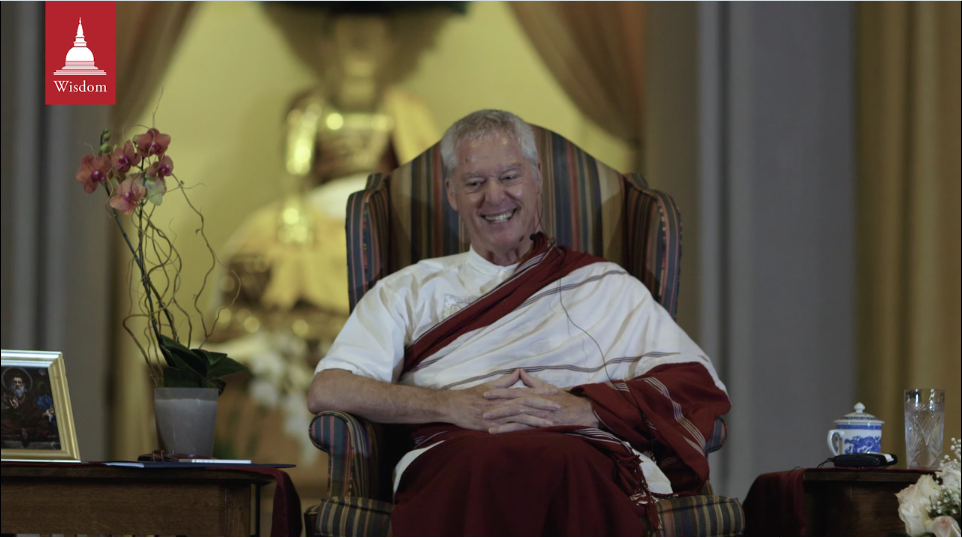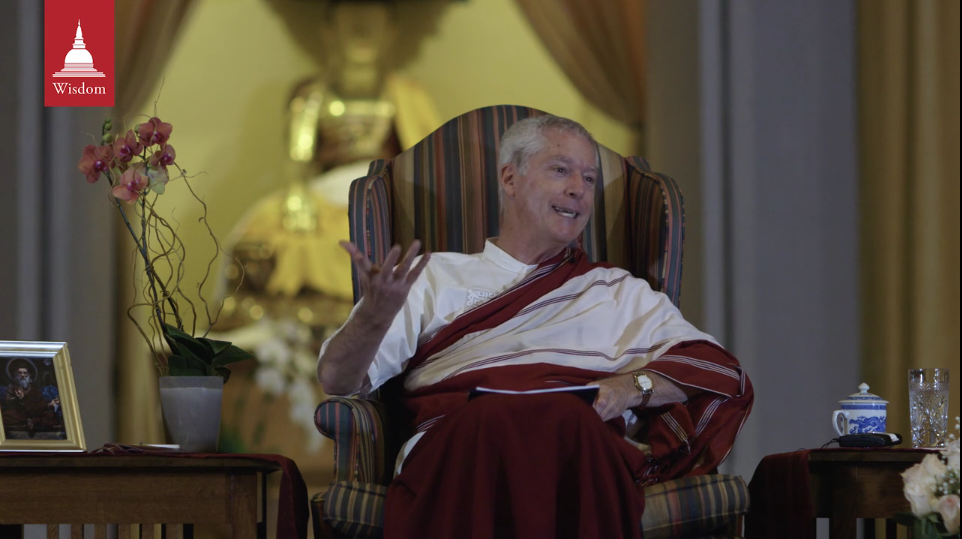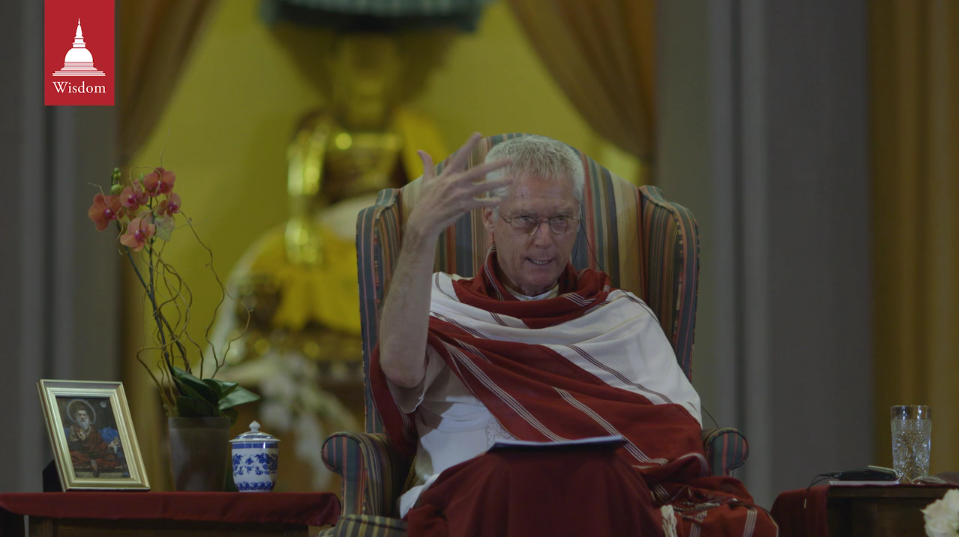You’ll hear this chime at the beginning of each of our meditative sessions, in the morning, afternoon, and evenings. And I invite you, as soon as you hear the chime, to let this induce, or catalyze, an automatic response, a type of Pavlovian response, one could say, not to salivate. No food is coming, but hearing the chime, let this immediately induce a sense of relaxation, of ease, of letting go, a sense of relief. Loosen up.
And while you may often feel that you’re located in your head, you’re up in your head, in your thoughts, your imaginations, and so on, let your awareness now descend, the locus of your awareness, descend into the body, into your torso, down to the thighs, down to the soles of your feet.
If you’re lying in the supine position, savasana or corpse position, bring your awareness down into the body, down all the way to the feet, but then down vertically, to the earth element, the sensations of your body in contact with your meditation mat, or if you’re sitting, the tactile sensations of firmness and solidity, where you feel your buttocks, your thighs on the chair, your body in touch with your meditation cushion, if you’re sitting in cross-legged position. Bring your awareness down, down to the ground.
In this way, ground your awareness, in this non-conceptual space of somatic sensations, specifically the sensations correlated to the earth element, the sensations of firmness and solidity. Rest your awareness in a witnessing mode, not imagining, not cogitating, not ruminating, or thinking about anything, but simply being present, mindfully aware of the sensations of your body in contact with the ground.
Then, like a fragrance filling a room, let your awareness fill, permeate the entire space of your body, through your legs, your torso, your arms, up to the crown of the head, and be mindfully present, throughout this entire somatic field.
Without visualizing the body, or thinking about it, simply be aware of the sensations arising from moment to moment, throughout this tactile field. And as you’re fully present within this field, you may notice areas that feel tight or constricted. For many people, tension mounts in the shoulders, the base of the neck. Wherever you might feel such tension or constriction, as the breath flows in gently, direct your attention to these areas, focusing there as you breathe in. And then as you breathe out, breath by breath, release. Release that tightness. Surrender your muscles to gravity. Every out breath as if a sigh of relief.
And of course, the face is a veritable magnet of tension. We see it in people’s facial expressions. The furrowed brow, the clenching of the jaws, the pursing of the lips, the tightening of the eyes themselves. Bring your awareness gently to the muscles of your face, as you breathe in. And as you breathe out, soften or relax the muscles around the mouth and the jaws. Relax all the muscles in the forehead. Let there be a spacious, open sense of the forehead, a spaciousness between the eyebrows, a softening of all the muscles around the eyes. And soften the eyes themselves. In short, settle or rest your entire face in an expression of repose, the whole face expressing a sense of ease, relaxation, carefree.
In this way, settle your whole body in a posture of ease, of comfort, and relaxation. And insofar as you are indeed comfortable and relaxed, you should find it easy to remain still, throughout the duration of this short session, with no unnecessary movement, no fidgeting, no scratching, no moving about, relaxed and still.
But to complete this settling of the body in its natural state, a state of dynamic equilibrium, you must emphasize a third quality, in addition to relaxation and stillness, and that is the quality of vigilance. So if you’re sitting upright, either on a chair or cross-legged, let your spine be straight, slightly lift your sternum, while keeping your abdominal muscles loose and relaxed, so you’re sitting at attention, so to speak. And with the sternum slightly lifted, the abdominal muscles loose, when you breathe in, you will feel the sensations of the breath, of the respiration flowing down and down, to the abdomen, which will expand as you breathe in, and contract as you breathe out. This is healthy breathing. Breathe from the bottom up.
If you’re in the supine position, simply let your spine be straight, and mentally or psychologically adopt a posture of vigilance, using this posture, this savasana, only for meditation, only for cultivating and refining the mind. Not for any other activity. And as you do so, by association, every time you slip into this posture, there will be the ambience, “Oh, I must be meditating. This is one of my meditative postures,” so adopt a posture, a psychological posture, of vigilance. Even while your body is utterly relaxed, let your mind be clear and alert. In this way, settle your body in its natural state, imbued with the three qualities of relaxation, stillness, and vigilance, a state of dynamic equilibrium.
Then we turn to a subtler domain of balance, of settling the speech in its natural state, which is one of effortless silence. Here, it’s quite clear, where we have our outer, or public, speech, and I think you’ve already achieved this. You’re silent, and effortlessly so. That’s not difficult. But what about the inner speech of the mind, the obsessive, compulsive flow of rumination, the commentary, the chit-chat, the leaky faucet of the mind? How to settle the mind inwardly, the speech of the mind, in a state of effortless silence, so you’re as inwardly calm and still as you are outwardly?
To facilitate this inner stillness, this inner quiet, we settle the respiration in its natural rhythm, which means allowing the breath to flow in and out, effortlessly and without constraint, relinquishing all control, all influence. Simply allowing the body to breathe, without intervention.
The key to settling the respiration in its natural rhythm is the out breath. With every exhalation, relax, and release your body more and more deeply. All the muscles of the body soften and relax. With every out breath, release the breath, and release, and release, until it’s all released, and you’re holding back nothing at all, nothing in reserve. This does not entail forcefully expelling the air, but rather releasing until it’s all flowed out. You can do this only if your mind is quiet, especially when you come to the end of the breath.
And with every out breath, release any thoughts, or images, memories that may have come to mind, as if this out breath were a gentle gust of breeze, blowing away dry, autumn leaves. As you breathe out, simply release any activities of the mind. Let them dissolve back into the space of awareness. So with every out breath, release your body, release the breath, release your mind completely.
And when you come to the end of the out breath, just rest, relax effortlessly, until the next breath flows in, unimpededly effortlessly, like a wave washing up on shore, and whether this in breath is long or short, deep or shallow, receive it as a gift. Don’t take it. Don’t pull it in. Don’t impede it. But simply accept it. Without helping it along or hindering it in any way, let the breath flow in, effortlessly.
And then, as the breath flows out again, release in the body, release the breath, release the mind, breath by breath, releasing, breath by breath, all that turbulent energy in the mind, that spews out, one thought and rumination after another. Breath as effortlessly, as if you were deep asleep, but vividly aware.
And finally, we turn to the mind, the subtlest challenge of settling the mind in its natural state, and we begin by relaxing the mind, from its very core, releasing all concerns, all hopes and fears about the future and the past, releasing all cogitations about the present, and setting the mind at ease, loose and relaxed. And in the release of all grasping, all desire and aversion, all hopes and fears, all memories and anticipations, let your awareness effortlessly come to rest, in stillness, in the present moment.
Awareness free of grasping, effortlessly still, is by nature, luminous and bright, clear and vivid, so rest in that dynamic equilibrium, your mind at ease, still, and clear. This is pre-meditation, so don’t focus your mind on anything, outwardly or inwardly. Don’t do anything with the mind. Release all striving, all effort. Release all desire. Release any focusing of attention, here or there. Not seek to modify the mind in any way. In short, rest in stillness, in inactivity, without doing anything at all, resting in the very nature of your awareness, which is luminous and cognizant.




